
Tyrannosaurus is a genus of large theropod dinosaur. The type species Tyrannosaurus rex, often shortened to T. rex or colloquially T-Rex, is one of the best represented theropods. It lived throughout what is now western North America, on what was then an island continent known as Laramidia. Tyrannosaurus had a much wider range than other tyrannosaurids. Fossils are found in a variety of rock formations dating to the latest Campanian-Maastrichtian ages of the late Cretaceous period, 72.7 to 66 million years ago, with isolated specimens possibly indicating an earlier origin in the middle Campanian. It was the last known member of the tyrannosaurids and among the last non-avian dinosaurs to exist before the Cretaceous–Paleogene extinction event.

Struthiomimus, meaning "ostrich-mimic", is a genus of ornithomimid dinosaurs from the late Cretaceous of North America. Ornithomimids were long-legged, bipedal, ostrich-like dinosaurs with toothless beaks. The type species, Struthiomimus altus, is one of the more common, smaller dinosaurs found in Dinosaur Provincial Park; their overall abundance—in addition to their toothless beak—suggests that these animals were mainly herbivorous or omnivorous, rather than purely carnivorous. Similar to the modern extant ostriches, emus, and rheas, ornithomimid dinosaurs likely lived as opportunistic omnivores, supplementing a largely plant-based diet with a variety of small mammals, reptiles, amphibians, insects, invertebrates, and anything else they could fit into their mouth, as they foraged.

Barnum Brown, commonly referred to as Mr. Bones, was an American paleontologist. He discovered the first documented remains of Tyrannosaurus during a career that made him one of the most famous fossil hunters working from the late Victorian era into the early 20th century.
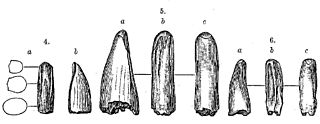
Aublysodon is a genus of carnivorous dinosaurs known only from the Judith River Formation in Montana, which has been dated to the late Campanian age of the late Cretaceous period. The only currently recognized species, Aublysodon mirandus, was named by paleontologist Joseph Leidy in 1868. It is sometimes considered dubious now, because the type specimen consists only of an isolated premaxillary (front) tooth. Although this specimen is now lost, similar teeth have been found in many US states, western Canada, and Asia. These teeth almost certainly belong to juvenile tyrannosaurine tyrannosaurids, but most have not been identified to species level. However, it is likely that the type tooth belongs to one of the species in the genus Daspletosaurus, which was present in contemporary formations, and which matches specific details of the original tooth. The synapomorphies alleged to distinguish the Aublysodontinae, especially lack of serrations on premaxillary teeth could have been caused by tooth wear in life, postmortem abrasion, or digestion. Most other "aublysodontine"-type teeth may be from ontogenetic stages or sexual morphs of other tyrannosaurids.

Tyrannosaurus rex is unique among dinosaurs in its place in modern culture; paleontologist Robert Bakker has called it "the most popular dinosaur among people of all ages, all cultures, and all nationalities". Paleontologists Mark Norell and Lowell Dingus have likewise called it "the most famous dinosaur of all times." Paleoartist Gregory S. Paul has called it "the theropod. [...] This is the public's favorite dinosaur [...] Even the formations it is found in have fantastic names like Hell Creek and Lance." Other paleontologists agree with that and note that whenever a museum erects a new skeleton or bring in an animatronic model, visitor numbers go up. "Jurassic Park and King Kong would not have been the same without it." In the public mind, T. rex sets the standard of what a dinosaur should be. Science writer Riley Black similarly states, "In all of prehistory, there is no animal that commands our attention quite like Tyrannosaurus rex, the king of the tyrant lizards. Since the time this dinosaur was officially named in 1905, the enormous carnivore has stood as the ultimate dinosaur."
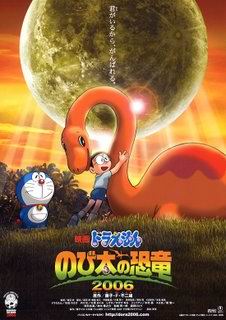
Doraemon: Nobita's Dinosaur 2006, also known as Doraemon: The Movie 2006 and Doraemon and the Little Dinosaur, is a 2006 Japanese animated science fiction adventure film which is a remake of the first, 1980, Doraemon film Doraemon: Nobita's Dinosaur. The new film was released theatrically in Japan on 4 March 2006. It's the 26th Doraemon film. The film got a private screening with English subtitles in Washington, D.C., on 14 November 2008, making it the first time Doraemon made an appearance in the US. The movie grossed over 3.28 billion yen.
Mary Higby Schweitzer is an American paleontologist at North Carolina State University, who led the groups that discovered the remains of blood cells in dinosaur fossils and later discovered soft tissue remains in the Tyrannosaurus rex specimen MOR 1125, as well as evidence that the specimen was a pregnant female when she died.

The Magic School Bus In the Time of the Dinosaurs is the sixth book in Joanna Cole and Bruce Degen's The Magic School Bus series.
Dinosaur Walk Museum was a series of attractions that feature life-size sculptures of dinosaurs and replicas of fossils. Branches of the museum were located in Riverhead, New York and Pigeon Forge, Tennessee.

Sue, officially designated FMNH PR 2081, is one of the largest, most extensive, and best preserved Tyrannosaurus rex fossils ever found, at over 90 percent recovered by bulk.
Phylogenetic bracketing is a method of inference used in biological sciences. It is used to infer the likelihood of unknown traits in organisms based on their position in a phylogenetic tree. One of the main applications of phylogenetic bracketing is on extinct organisms, known only from fossils, going back to the last universal common ancestor (LUCA). The method is often used for understanding traits that do not fossilize well, such as soft tissue anatomy, physiology and behaviour. By considering the closest and second-closest well-known organisms, traits can be asserted with a fair degree of certainty, though the method is extremely sensitive to problems from convergent evolution.

The Geological Museum of China, built in 1916, is a geological museum, boasting 200 thousand specimens.

Tyrannosaurus is one of the most iconic dinosaurs and is known from numerous specimens, some of which have individually acquired notability due to their scientific significance and media coverage.

Sea Monsters: A Prehistoric Adventure is a 2007 American IMAX 3D documentary film by National Geographic, about prehistoric marine reptiles. It alternates modern-day sequences about the work of scientists studying the animals with computer-animated scenes depicting the prehistoric past.

Doraemon: Nobita's Dinosaur is a 1980 Japanese animated science fiction adventure film based on the manga series Doraemon, particularly the first volume of the same name of the Doraemon Long Stories series. The film premiered on 15 March 1980 in Japan. It is the first feature-length Doraemon film. In 2006, the film was remade as Doraemon: Nobita's Dinosaur 2006. It is an expanded version of the 1975 chapter with the same name.
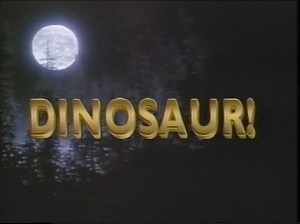
Dinosaur! is a 1985 American television documentary film about dinosaurs. It was first broadcast in the United States on November 5, 1985, on CBS. Directed by Robert Guenette and written by Steven Paul Mark, Dinosaur! was hosted by American actor Christopher Reeve, who some years before had played the leading role in Superman.
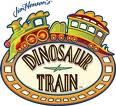
Dinosaur Train is an animated television series aimed at preschoolers ages 3 to 6 and created by Craig Bartlett, who also created Nickelodeon's Hey Arnold!. The series features a Tyrannosaurus rex named Buddy who, together with the rest of his family, who are all Pteranodons, takes the Dinosaur Train to explore the Mesozoic, and have adventures with a variety of dinosaurs. It is co-produced by The Jim Henson Company in association with the Infocomm Media Development Authority, Sparky Animation, FableVision, Snee-Oosh, Inc., Reel FX, and Sea to Sky Entertainment. As of September 2018, PBS Kids had ordered 11 more episodes, taking the total number of episodes to 100. A film based on the series from Universal Pictures and Universal 1440 Entertainment titled, Dinosaur Train: Adventure Island premiered on April 12, 2021.
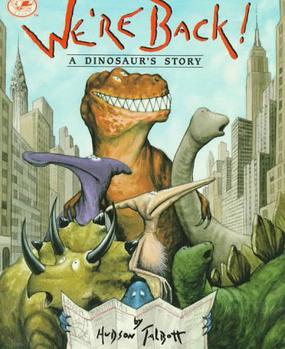
We're Back! A Dinosaur's Story is a 1987 children's book drawn and written by Hudson Talbott, and published by Crown. A Tyrannosaurus Rex named Rex is the main character and narrator. Other dinosaurs included in the book are a Triceratops, a Saurolophus, an Apatosaurus, a Stegosaurus, and a Dryosaurus, with the only exception being the Pteranodon, a pterosaur.

The Morrison Natural History Museum is a natural history museum located in Morrison, Colorado. The exhibits include several dinosaur fossils that were found nearby. Hands-on exhibits are designed to appeal to both children and adults, scientists and non-scientists.

A five-minute prologue to the 2022 film Jurassic World Dominion was released in 2021, initially as an IMAX-exclusive preview and later as an online short film. It is the second live-action short film in the Jurassic Park franchise, following Battle at Big Rock (2019). The prologue includes a prehistoric segment set during the Cretaceous, depicting various dinosaurs in their natural habitats. The sequence was shot on the island of Socotra, part of Yemen. The prologue also includes a modern-day sequence – filmed in England and set in California – in which a Tyrannosaurus rex terrorizes a drive-in theater while evading capture.

















